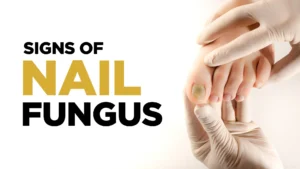Artificial nails like acrylics and gels have become popular for beautiful, long-lasting manicures. However, while they enhance the appearance of your nails, they can also increase the risk of developing nail fungus. This article will explore the connection between fake nails and fungal infections, provide practical tips to prevent them, and offer guidance on effective treatments.
What Is Nail Fungus?
Nail fungus, medically known as onychomycosis, is a common condition that causes nails to become discolored, thickened, and brittle. Fungi thrive in warm, moist environments, making the area beneath artificial nails an ideal breeding ground. When moisture becomes trapped between the natural and fake nails, it can lead to fungal growth.
How Do Fake Nails Contribute to Fungal Infections?
Artificial nails can create a sealed environment where moisture accumulates, mainly if improperly applied or maintained correctly. This trapped moisture provides an excellent habitat for fungi. Additionally, if the artificial nail becomes loose or damaged, it can create gaps where fungi can enter and multiply. Improper sterilization of manicure tools can also introduce fungi, leading to infections.
Preventing Nail Fungus with Artificial Nails
To enjoy the beauty of fake nails without compromising your nail health, consider the following preventive measures:
- Choose a Reputable Salon: Ensure the salon follows strict hygiene practices. Tools should be sterilized between clients to prevent the spread of infections.
- Give Your Nails a Break: Avoid wearing artificial nails continuously. Allow your natural nails to breathe between applications to reduce the risk of infection.
- Monitor Your Nails: Regularly check for signs of discoloration, lifting, or other abnormalities. Early detection of issues can prevent more severe infections.
Proper Application and Removal: To minimize damage to your natural nails, have trained professionals apply and remove artificial nails. Avoid aggressive filing or drilling, which can thin and weaken the natural nail, making it more susceptible to infection.

Recognizing the early signs of nail fungus can lead to prompt treatment. Look out for:
- Discoloration: Yellow, brown, or white spots under the nail.
- Thickening: Nails become unusually thick or distorted.
- Brittleness: Crumbly or ragged edges.
- Odor: A slight foul smell emanating from the nail.
If you notice any of these symptoms, acting promptly is essential.
Treating Nail Fungus from Fake Nails
If a fungal infection develops, consider the following steps:
- Remove the Artificial Nails: The affected area can be exposed and treated effectively.
- Consult a Healthcare Professional: They can diagnose the infection and recommend appropriate treatment, which may include topical or oral antifungal medications. This professional guidance will give you confidence and security in your treatment.
- Home Remedies: Some individuals find relief using home treatments:
- Vinegar Soak: Soaking the affected nail in a solution of one part vinegar to two parts warm water for 15–20 minutes daily may help inhibit fungal growth.
- Listerine Soak: Listerine mouthwash contains antifungal properties. Soaking the affected nails for 15–20 minutes a few times a week may be beneficial.
- Vick’s VapoRub: Applying a small amount to the affected area daily has been reported to help in some cases.
It’s important to note that while these home remedies may be helpful for some, they are not guaranteed to work for everyone. Proper diagnosis and treatment require consulting with a healthcare professional.
Maintaining Healthy Nails
Regular nail care and hygiene play a significant role in preventing nail fungus. Whether you choose to wear artificial nails or not, follow these general tips:
- Keep Nails Clean and Dry: Wash your hands and feet regularly and dry them thoroughly, especially after bathing or swimming.
- Trim Nails Properly: Cut nails straight across and file down thickened areas.
- Wear Breathable Footwear: Choose shoes that allow air circulation to prevent moisture buildup.
- Use Antifungal Products: Consider using antifungal sprays or powders, especially if you’re prone to infections.
Final Thoughts
While artificial nails can give your hands an elegant look, improper use and poor nail hygiene can increase the risk of onychomycosis. By taking preventive steps, allowing nails time to recover, and seeking treatment promptly, you can enjoy beautiful nails without the risk of fungal infections.
For professional nail health consultations, book your free online consultation or contact our specialists today.
📞 London: 020 4536 6000
📞 Glasgow: 0141 488 8985
🌐 Visit: harleystreetmedics.clinic



